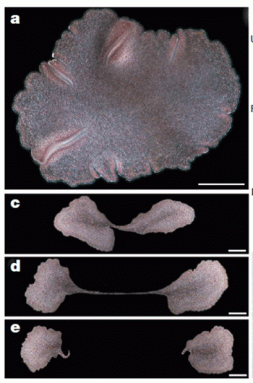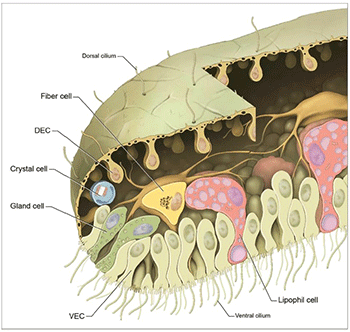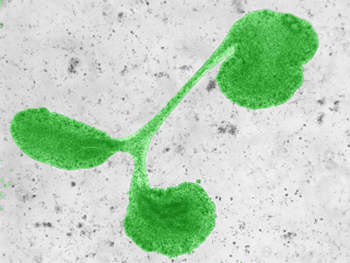Animals With No Mouth, Gut Or Tissues Will Be Sponges ?
Living Mysteries launches every bit an occasional series on organisms that stand for evolutionary curiosities.
Franz Eilhard Schulze had a laboratory full of beautiful sea creatures. In the 1880s, he was one of the world'southward peak experts on sea sponges. He institute many new species and filled saltwater aquariums at the Academy of Graz in Austria with these simple bounding main animals. They were striking — brightly colored with exotic shapes. Some looked similar flower vases. Others resembled miniature castles with pointy towers.
Merely today, Schulze is best remembered for something very different — a drab little fauna no larger than a sesame seed.
He discovered it i 24-hour interval past pure blow. It was hiding in one of his fish tanks. Creeping along the inside of the glass, it was dining on the light-green algae that grew there. Schulze named it Trichoplax adhaerens (Effort-koh-plaks Ad-HEER-ens). That's Latin for "hairy sticky plate" — which is well-nigh what information technology looks like.
To this day, Trichoplax remains the simplest animal known. It has no mouth, no stomach, no muscles, no blood and no veins. It has no front or back. Information technology is nothing but a apartment sheet of cells, thinner than newspaper. Information technology is only three cells thick.
This picayune blob might expect boring. But scientists are interested in Trichoplax precisely considering it is so simple. It shows what the very first animals on Earth might take looked like, 600 million to 700 million years ago. Trichoplax is even providing hints about how uncomplicated animals later evolved more complicated bodies — with mouths, stomachs and nerves.
A hungry suction cup
At showtime glance, Trichoplax does not fifty-fifty look like an animal. Its flat trunk constantly changes shape every bit information technology moves. Equally such, it resembles a blob chosen an amoeba (Uh-MEE-buh). Amoebas are a type of protist, single-celled organisms that are neither plants nor animals. But when Schulze looked through his microscope in 1883, he could run across several clues that Trichoplax truly was an animate being.

Trichoplax can reproduce past splitting in two. Each piece so becomes its own new animal.
Emina Begovic
Some amoebas are larger than this creature. Merely an amoeba has merely one jail cell. In contrast, the trunk of a Trichoplax has at least 50,000 cells. And though this animal lacks a stomach or heart, its body is organized into different kinds of cells that perform unlike tasks.
This "division of labor between cell types" is a hallmark of animals, explains Bernd Schierwater. He works at the Institute for Animal Ecology and Jail cell Biology in Hannover, Germany. He's a zoologist who has been studying Trichoplax for 25 years.
Cells on the underside of Trichoplax have tiny hairs called cilia (SILL-ee-uh). The animal moves by twirling these cilia like propellers. When the fauna finds a patch of algae, it stops. Its apartment body settles downwardly atop the algae like a suction loving cup. Some special cells on the underside of this "suction cup" eject out chemicals that break down the algae. Other cells absorb the sugars and other nutrients released from this meal.
So the animal'due south entire underside works as a stomach. And since its tummy is on the outside of its torso, information technology doesn't need a mouth. When it finds algae, a Trichoplax but plops itself onto the food and begins to digest it.
Clues about the outset animals
Schierwater believes that the first animals on Globe must take looked a lot similar Trichoplax.
When those animals appeared, the oceans were already full of unmarried-celled protists. Much every bit Trichoplax do, those protists swam past twirling their cilia. Some protists even formed colonies. They gathered into assurance, chains or sheets made of thousands of cells. Many protists alive today also form colonies. But these colonies are not animals. They are but clumps of identical, single-celled organisms that happen to be living in harmony.
Then, 600 million to 700 one thousand thousand years ago, something happened. 1 group of ancient protists formed a new type of colony. Each member's prison cell started out the aforementioned. But over time, those cells began to change. Once identical, they somewhen morphed into two different types. All of the cells nonetheless independent the aforementioned DNA. They had exactly the same genes. Merely now the cells began chatting with each another. To exercise that, they released chemicals that served as letters. These told cells in different parts of the colony to do different things. Says Schierwater, this would have been the first fauna.
He suspects that this first creature must take been a flat sheet, much like Trichoplax. It would have been just two cells thick. Those on the bottom allow it clamber and digest food. Cells on the tiptop did something else. Maybe they protected the animal from protists out to swallow information technology.
It makes sense that the first animal would be flat. Just consider what the ocean looked like back then. Shallow areas of the seafloor were covered with a gooey carpet of unmarried-celled microbes and algae. The start animal would take crept atop this "microbial mat," Schierwater says. Information technology would have digested the microbes and algae berneath it — simply as Trichoplax does.
That first animal was probably no larger than Trichoplax. It left no fossils. Only larger, similar animals evolved over time. Scientists have plant fossils that wait like giant versions of Trichoplax.
One, known as Dickinsonia, lived some 550 million to 560 million years agone. It was up to ane.two meters (4 feet) across. No one knows whether information technology would have been related to Trichoplax. It moved and ate the way Trichoplax does, crawling effectually and then plopping downward on a meal. Like Trichoplax, it had no organs — tissues similar a brain or eyes that piece of work together to perform a particular task. But its torso was a bit circuitous in other means. It had front and back ends and left and correct sides. Its flat body also was divided into segments, like a quilted blanket.
Mouth and butt — an animal starter kit?
For Schierwater, information technology is easy to imagine how such a elementary fauna could evolve a more complex body. Start with a plate of cells, like Trichoplax, whose stomach is its entire underside. The edges of that plate might gradually lengthen until it looked like a bowl sitting upside down. The opening of the bowl might narrow until information technology looked like an upside-down vase.
Story continues below image.

This series of drawings shows how early on animal shapes may accept evolved 500 meg to 700 million years ago. The scarlet part shows cells that can assimilate food. As the body shape evolved from a flat "plate" to a bowl to a vase, those cells formed a stomach inside the animal's torso.
Schierwater lab
"Now you lot have a mouth," says Schierwater. It's the opening of the vase. Inside that vase is at present the stomach.
When this primitive animal has digested its food, it just spits back out any unneeded remains. Some modern animals practise this. Amongst them are jellyfish and sea anemones (Uh-NEMM-oh-nees).
Over millions of years, Schierwater suggests, this vase-shaped trunk stretched. As it got longer, it made a hole at each end. One pigsty became the mouth. The other, an anus, was where it pooped out wastes. This is the type of digestive organisation seen in bilaterian (By-lah-TEER-ee-an) animals. Bilaterians are a stride past anemones and jellyfish on the evolutionary tree of life. They include all animals with right and left sides and front end and back ends: worms, snails, insects, crabs, mice, monkeys — and, of form, united states of america.
Deceptively simple
Schierwater's idea that the starting time animal looked similar Trichoplax gained some support in 2008. That twelvemonth, he and 20 other scientists published its genome (JEE-noam). That'due south its full string of Deoxyribonucleic acid, containing all of its genes. Trichoplax might look simple on the outside. But its genes pointed to a somewhat complex inner life.

A cantankerous section showing structures inside of the body of a Trichoplax, the simplest known animal. Information technology has only six different types of cells. Sponges, another simple blazon of creature, have 12 to 20 prison cell types. Fruit flies have around fifty prison cell types and humans take several hundred.
Smith et al/Current Biology 2014
This brute has only 6 types of cells. For comparison, a fruit fly has 50 types. But Trichoplax boasts 11,500 genes — 78 pct as many as a fruit fly.
In fact, Trichoplax has many of the aforementioned genes that more complex animals use to shape their bodies. 1 factor is called brachyury (Brack-ee-YUUR-ee). Information technology helps class the vase shape of an animal, with its tum on the inside. Some other gene helps divide the body — from front to back — into different segments. It'due south known every bit a Hox-similar gene. And as this name implies, the gene is similar to Hox genes, which shape insects into front, centre and back parts. In people, Hox genes divide the spine into 33 divide bones.
"It was a surprise" to come across then many of these genes in Trichoplax, says Schierwater. This suggests that a apartment, primitive beast already had many of the genetic instructions that animals would demand to evolve a more complicated body. It was just using those genes for dissimilar purposes.
Get-go nerves
Trichoplax turned out to accept ten or 20 of the genes that in more circuitous animals help create nerve cells. And this actually grabbed the interest of biologists.
In 2014, scientists reported that Trichoplax has a few cells that human action surprisingly like nervus cells. These so-called gland cells are scattered across its underside. They contain a special set of proteins known as SNARE. These proteins also show up in the nervus cells of many more complex animals. In those animals, they sit at synapses (SIN-alcove-uhs). These are places where i nerve cell connects to another. The proteins' task is to release chemic messages that move from i nerve cell to the next.
A gland cell in Trichoplax looks much like a nerve jail cell at a synapse. Information technology, as well, is packed with little bubbles. And but as in nerve cells, those bubbles shop a kind of messenger chemical. Information technology'south known equally a neuropeptide (Nuur-oh-PEP-tyde).
Last September, scientists reported that gland cells really control the behavior of Trichoplax. When this animal creeps over a patch of algae, these cells "gustation" the algae. That informs the fauna that it'southward fourth dimension to stop creeping.
A unmarried gland jail cell can do this by releasing its neuropeptides. Those neuropeptides tell nearby cells to stop twirling their cilia. This puts putting on the brakes.
The chemicals too communicate with other nearby gland cells. They tell their neighbors to dump out their own neuropeptides. Then this "end and eat" message at present spreads from cell to jail cell across the unabridged animal.
Carolyn Smith looks at Trichoplax and sees a nervous organization that is but starting to evolve. In a sense, it is a nervous arrangement without nerve cells. Trichoplax uses some of the same nerve proteins that more complex animals utilise. But those aren't yet organized into specialized nerve cells. "We're thinking of it equally like a proto-nervous system," says Smith. As early animals connected to evolve, she explains, "those cells essentially became neurons."
Smith is a neurobiologist at the National Institutes of Health in Bethesda, Dr.. She and her married man, Thomas Reese, discovered the nervus-like properties of gland cells. Three months ago, they described another function of Trichoplax'south proto-nervous system. They institute cells containing a kind of mineral crystal. That crystal always sinks to the bottom of the prison cell, whether Trichoplax is level, tilted or upside downward. In this fashion, the animal uses these cells to "experience" which management is up and which is down.
Creature carries serpent-like venom
Trichoplax isn't just teaching biologists about evolution, however. Scientists still are learning surprisingly bones things nearly how this animal lives. For one thing, it tin can fly! (Sort of.) Also it is deadly poisonous. And it may spend part of its life sneaking around in an entirely different shape — a disguise that scientists still haven't recognized.
For a century after Trichoplax'southward discovery, people had thought the creature could simply clamber. In fact, they are skilled swimmers. And that may exist how they spend much of their fourth dimension, Vicki Pearse discovered. She's a biologist, recently retired from the Academy of California, Santa Cruz. Back in 1989, she was traveling from one island to another in the Pacific Sea.
She collected Trichoplax wherever she went. Afterward, she spent hours watching them under a microscope. Ane 24-hour interval, she spotted one swimming through the water "similar a petty flying saucer." In one case she learned to look for it, she often saw the animals pond this fashion.
This wasn't the only weird discovery that she made that year. Another time at her microscope, she watched Trichoplax being chased by a snail. She was sure she was going to meet the footling fellow get eaten. Simply as soon as the snail defenseless hold of Trichoplax, it pulled back every bit if it had touched a hot stove.
"They look completely defenseless," she says of Trichoplax. "They're but a little blob of tissue. They should be delicious." Just not once did she run across a hungry predator really eat one. Instead, the hunter ever seemed to alter its mind at the last second. "There must be something nasty about them," Pearse thought.
The mystery was solved years later, in 2009. That'southward when some other scientist discovered that Trichoplax can sting an animal that tries to consume it. That sting can actually paralyze its would-be predator. It uses tiny dark balls, found on its upper side, to do this.
People had always thought those assurance were just globs of fat. But instead, they hold some kind of venom thatTrichoplax releases when attacked. In fact, the animal has genes that look a lot like the venom genes of certain poisonous snakes, such as the American copperhead and the West African carpet viper. A little bleep of that venom means nothing to a large man. But if you're a tiny snail, it can ruin your twenty-four hours.
Secret life
Pearse believes that scientists are all the same missing something big about Trichoplax. These animals usually reproduce by splitting in half. That gives ascent to two animals. At least that'southward what scientists encounter when they grow them in the laboratory. In one case in a while, Pearse has seen one of these animals break into a dozen or more than tiny pieces. Each would go on to become a new niggling animal.

Trichoplax does not always just split up into two new animals. Sometimes it divides into three, every bit this one is doing. The animal has fifty-fifty been seen breaking upwardly into x or more pieces that each develop into consummate new animals.
Schierwater lab
Just Trichoplax also reproduces sexually, as most other animals practice. Here, a sperm — a male reproductive prison cell — seems to fertilize an egg prison cell from another private. Scientists know this considering they can discover Trichoplax whose genes are a mix of two others. This suggests that the animal had a mother and begetter. Trichoplax also has genes that are involved in making sperm. Despite this genetic prove of sex, says Pearse, "no one's ever caught them at it."
She also wonders if these animals have another life stage that no one knows about. Many ocean animals, such every bit sponges and coral, start out as a tiny, baby larvae. Each larva swims around like a footling tadpole. Merely later does information technology land on a stone and abound into a sponge or a coral — 1 that volition stay put for the residual of its life.
Trichoplax could also have a pond larval phase. That larva's trunk could wait very different from the "sticky hairy plate" into which it later morphs. It also could help explain why such a simple-seeming animate being has so many genes. Shaping and building that larval body would crave many genetic instructions.
Pearse hopes that scientists tin can one day reply all of these questions. "These are mystery animals," she says. "They have all kinds of puzzles waiting to exist solved."
Source: https://www.sciencenewsforstudents.org/article/living-mysteries-meet-earths-simplest-animal
Posted by: hiserwarge1965.blogspot.com



0 Response to "Animals With No Mouth, Gut Or Tissues Will Be Sponges ?"
Post a Comment